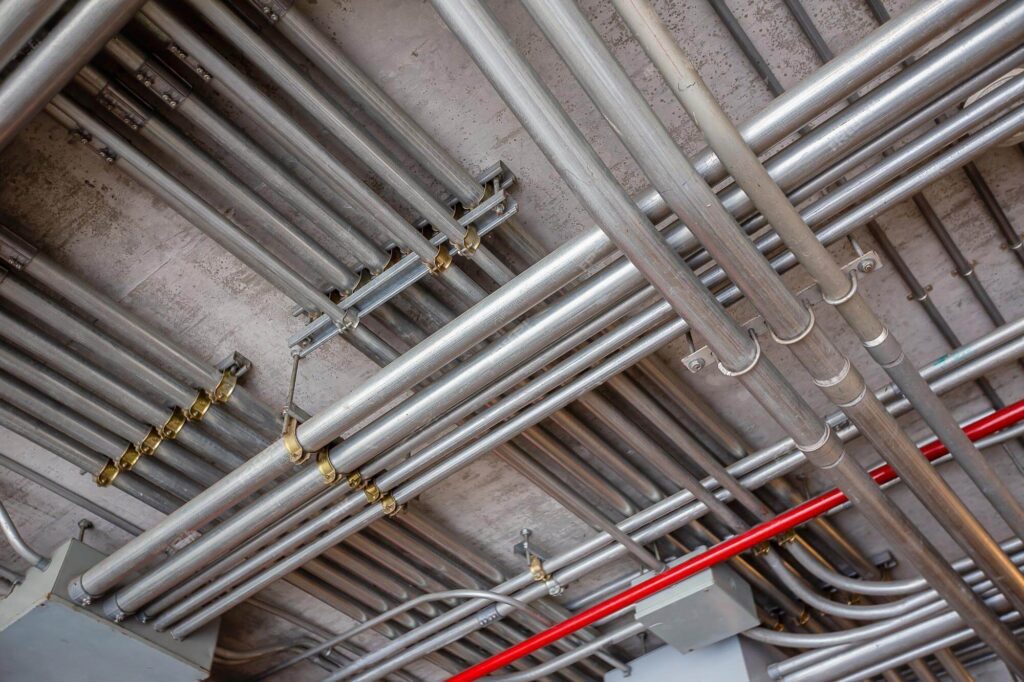Electrical Metallic Tubing (EMT Conduit ) conduit is a widely used type of electrical conduit in residential, commercial, and industrial wiring systems. Recognized for its durability, affordability, and versatility, EMT conduit is a key component in electrical installations. In this article, we will explore the characteristics, uses, advantages, installation techniques, and regulatory guidelines surrounding EMT conduit.
What is EMT Conduit?
Electrical Metallic Tubing (EMT), also known as “thin-wall” conduit, is a type of electrical tubing that provides physical protection and routing for electrical wiring. EMT is made from galvanized steel or aluminum, giving it a lightweight yet strong structure. It is a non-armored conduit, meaning it does not have an insulating layer of metal around the wires inside but still provides a level of protection against physical damage.
EMT conduit is characterized by its thin wall thickness, which makes it lighter and easier to handle compared to other types of conduit like Intermediate Metal Conduit (IMC) or rigid metal conduit (RMC). However, EMT is still able to meet the required standards for safety and durability in most electrical systems.
Materials Used in EMT Conduit
The two primary materials used for EMT conduit are galvanized steel and aluminum.
- Galvanized Steel: This is the most common material for EMT conduit. The steel is coated with a layer of zinc, which helps protect it from corrosion, making it ideal for indoor and outdoor applications. Galvanized steel provides excellent strength and durability, especially when exposed to harsh environments.
- Aluminum: While less common, EMT conduit is also available in aluminum. Aluminum conduit is lighter than steel, making it easier to handle, especially in large installations. It also resists corrosion well, making it a popular choice in environments where rust or corrosion from moisture is a concern, such as in coastal areas.
Applications of EMT Conduit
EMT conduit is used in a variety of electrical wiring systems across different types of construction projects. Below are some common applications:
- Residential Wiring: EMT is often used in home electrical installations, particularly in areas like basements, garages, or outdoor settings. It offers a cost-effective way to protect wires from physical damage while maintaining a clean, organized look for the wiring system.
- Commercial and Industrial Buildings: In commercial and industrial settings, EMT conduit is frequently used for both exposed and concealed wiring systems. Its robust structure helps safeguard wiring from mechanical damage, and it is often chosen because of its flexibility in design.
- Outdoor Applications: Although EMT is primarily designed for dry, indoor environments, it can also be used outdoors if the proper fittings and supports are employed to prevent exposure to the elements.
- Underground Installations: While EMT is typically not used for direct burial, it can be used in above-ground conduit runs that are then buried in trenches or ducts as part of a larger system.
Advantages of EMT Conduit
EMT conduit provides numerous advantages, making it a preferred choice for electricians and engineers alike. Some key benefits include:
- Cost-Effective: Compared to heavier conduits like RMC and IMC, EMT is more affordable, making it an attractive choice for budget-conscious projects. Its relatively low material cost and ease of installation contribute to overall cost savings.
- Lightweight and Easy to Handle: One of the most significant advantages of EMT is its lightweight construction. This makes it easier to transport and install, reducing the labor required and speeding up the installation process.
- Durability and Protection: EMT provides a level of protection to electrical wires from physical damage, such as impact, abrasion, or even exposure to chemicals. The galvanized steel construction offers excellent resistance to corrosion and rust.
- Aesthetic Appeal: EMT has a clean, modern look that works well with contemporary building designs. It’s often used in exposed systems because of its sleek appearance and the ability to be neatly routed along walls and ceilings.
- Flexibility: EMT is relatively easy to bend, especially with the use of the proper tools, like a conduit bender. This flexibility allows for smoother routing through tight spaces, corners, and angles.
- Fire Safety: EMT conduit is non-combustible, which means it does not burn, unlike plastic conduits. In the event of a fire, EMT helps prevent the spread of flames and may help protect the wiring inside.
Installation of EMT Conduit
Installing EMT conduit requires a bit of knowledge and skill, but with the right tools, the process is manageable. Below are some essential steps and considerations for EMT installation:
- Cutting EMT Conduit: EMT conduit is relatively easy to cut using a hacksaw, pipe cutter, or a specialized EMT cutter. It’s important to ensure the cut ends are smooth to avoid damaging wires when they are pulled through the conduit.
- Bending EMT Conduit: Bending EMT requires a conduit bender, which is a tool that ensures the conduit is bent to the correct angle without kinking or damaging the tube. Bends can be made for 90-degree angles, offsets, or simple curves, depending on the needs of the installation.
- Joining Sections of EMT: To connect sections of EMT conduit, use special fittings such as connectors, couplings, and elbows. These are designed to allow for secure, tight joints that maintain the integrity of the conduit system. It’s essential that the fittings are properly installed to prevent loose connections that could lead to electrical hazards.
- Securing EMT Conduit: EMT conduit must be securely mounted using straps or brackets. The National Electrical Code (NEC) specifies the maximum distance between supports for EMT conduit, typically no more than 10 feet for horizontal runs and 3 feet for vertical runs. Properly supporting the conduit ensures it remains stable and protects the wiring inside.
- Grounding: While EMT conduit itself is conductive, it is important to ensure that the conduit is properly grounded to prevent electrical shocks. Grounding is typically achieved by bonding the conduit to the electrical panel using grounding conductors.
Regulatory Guidelines for EMT Conduit
Like all electrical components, EMT conduit must adhere to strict safety standards and codes to ensure proper performance and safety. The National Electrical Code (NEC) governs the use of EMT conduit in the United States, and certain sections must be followed:
- Section 358 of the NEC: This section specifies the materials, installation techniques, and safety guidelines for EMT conduit. It outlines requirements for bending, cutting, and securing EMT, as well as the maximum allowable distance between supports.
- Weather and Environmental Considerations: If EMT conduit is exposed to outdoor elements, it must be installed with proper weatherproofing and fittings. It should be noted that EMT conduit is generally not designed for direct burial.
- Use in Hazardous Locations: In environments where flammable gases or vapors are present, additional guidelines and restrictions may apply. EMT can be used in some hazardous locations, but special fittings and additional safety considerations may be required.
- Grounding Requirements: For grounding purposes, EMT conduit must be properly bonded to ensure that any fault current is safely directed to the ground. The NEC outlines specific grounding techniques and wire gauge requirements based on the size of the conduit and wiring system.
Conclusion
EMT conduit is an essential part of electrical systems, offering protection, durability, and a clean aesthetic in various applications. Whether in residential, commercial, or industrial settings, EMT provides a reliable and cost-effective way to safeguard wiring and ensure safety and functionality. Understanding its material properties, installation methods, and regulatory guidelines helps ensure that EMT conduit performs as expected and meets necessary safety standards. With its ease of installation, flexibility, and robust protection, EMT remains a popular choice for electrical professionals worldwide.

